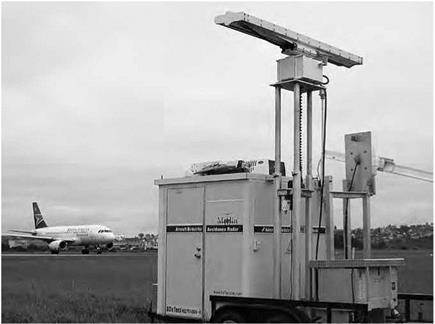Avoiding Bird Hazards: 1966
After millions of years of birds having the sky to themselves, it only took 9 years from the time the Wright brothers first flew in 1903 for the first human fatality brought about by a bird striking an aircraft and causing the plane to crash in 1912. Fast-forward to 1960, when an Eastern Air Lines plane went down near Boston, killing 62 people as a result of a bird strike—the largest loss of life from a single bird incident.[192]
With the growing number of commercial jet airplanes, faster aircraft increased the potential damage a small bird could inflict and the larger airplanes put more humans at risk during a single flight. The need to address methods for dealing with birds around airports and in the skies also rose in priority. So, on September 9, 1966, the Interagency Bird
|
A DeTect, Inc., MERLIN bird strike avoidance radar is seen here in use in South Africa. NASA uses the same system at Kennedy Space Center for Space Shuttle missions, and the FAA is considering its use at airports around the Nation. NASA. |
Hazard Committee was formed to gather data, share information, and develop methods for mitigating the risk of collisions between birds and airplanes. With the FAA taking the lead, the Committee included representatives from NASA; the Civil Aeronautics Board; the Department of Interior; the Department of Health, Education, and Welfare; and the U. S. Air Force, Navy, and Army.[193]
Through the years since the Committee was formed, the aviation community has approached the bird strike hazard primarily on three fronts: (1) removing or relocating the birds, (2) designing aircraft components to be less susceptible to damage from bird strikes, and (3) increasing the understanding of bird habitats and migratory patterns so as to alter air traffic routes and minimize the potential for bird strikes. Despite these efforts, the problem persists today, as evidenced by the January 2009 incident involving a US Airways jet that was forced to ditch in the Hudson River. Both of its jet engines failed because of
bird strikes shortly after takeoff. Fortunately, all souls on board survived the water landing thanks to the training and skills of the entire flightcrew.[194]
NASA’s contributions in this area include research to characterize the extent of damage that birds might inflict on jet engines and other aircraft components in a bid to make those parts more robust or forgiving of a strike,[195] and the development of techniques to identify potentially harmful flocks of birds[196] and their local and seasonal flight patterns using radar so that local air traffic routes can be altered.[197]
Radar is in use to warn pilots and air traffic controllers of bird hazards at the Seattle-Tacoma International Airport. As of this writing, the FAA plans to deploy test systems at Chicago, Dallas, and New York airports, as the technology still needs to be perfected before its deployment across the country, according to an FAA spokeswoman quoted in a Wall Street Journal story published January 26, 2009.[198]
Meanwhile, a bird detecting radar system first developed for the Air Force by DeTect, Inc., of Panama City, FL, has been in use since 2006 at NASA’s Kennedy Space Center to check for potential bird strike hazards before every Space Shuttle launch. Two customized marine radars scan the sky: one oriented in the vertical, the other in the horizontal. Together with specialized software, the MERLIN system can detect flocks of birds up to 12 miles from the launch pad or runway, according to a company fact sheet.
In the meantime, airports with bird problems will continue to rely on broadcasting sudden loud noises, shooting off fireworks, flashing strobe lights, releasing predator animals where the birds are nesting, or, in the worst case, simply eliminating the birds.











